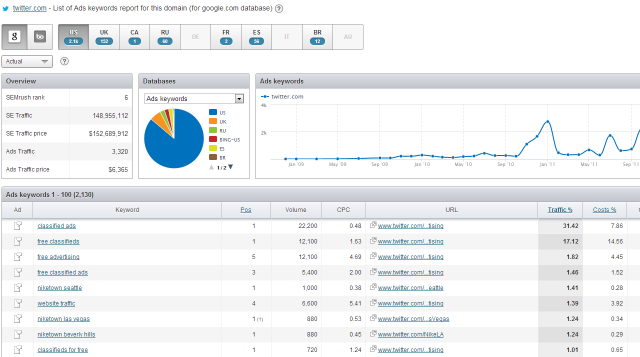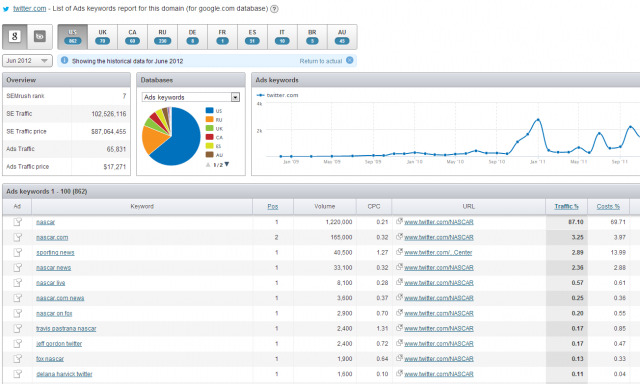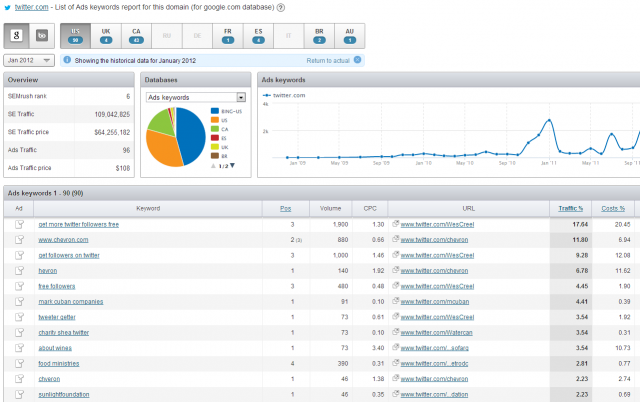There has been a lot of talk of Twitter in the news lately and since my previous articles were focused on Facebook, I figured I would turn the tables this time around.
The Library of Congress is trying to make a searchable Twitter archive, Twitter is a means of boosting Google searches and overall rankings, and this just came in: the word ‘hashtag’ is the word of the year as announced by The American Dialect Society.
There is always news of which celebrities tweeted what and apparently, tweets are beginning to have quite the impact on the social media world as a whole. Honestly, I didn’t even start a Twitter account until the very end of 2012 (don’t ask what took me so long) and since it is such a global phenomenon, completing an analysis of ads keywords allocation globally with current and historical data brings some interesting, and perhaps unexpected, results to light.
Twitter Ads Keywords, December 2012 (Current):
For the most current data pulled in December of 2012, approximately 86.20% of Twitter’s ads keywords were within the United States, with the UK trailing behind at 6.15%, Russia with 2.43% and Spain with 2.27%. Obviously at the present time, most advertising focus in Twitter is within the United States. In viewing specific keywords, we can tell that most in the United States are focused on classifieds, leading to this URL.
In June, a lesser 63.99% of ads were within the United States, while ads in Russia were greater with 17.07%. The UK came in next with 5.20%, Canada with 4.45% and finally Spain with 3.79%. At that time, there was a bit more of a diverse focus for Twitter not only in the geographic distribution but also in keywords. As can be seen, within the United States database there was much advertising for Nascar, which makes obvious sense seeing as how it was an extremely popular event during that month. The most popular keyword in Russia was Gleb Arkhangelsky, the President of a company in Russia called TimeManagement, Ltd.
Twitter Ads Keywords, January 2012:
Next, we’re going to jump way back (almost) an entire year to January of 2012. As we all know, a great many things can change over the course of a year and the historical data confirms just that. The graph above for January of 2012 shows a vast difference in global allocation and ads keywords data. The largest distribution that Twitter had for their ads keywords was to Bing with 45.69%. Next in line was the United States with 33.71%, Canada with 16.10%, and the remaining countries had miniscule ads keywords with Twitter. Additionally, the keywords vary in the United States. Ads ranged from those such as get more twitter follows free, and there was an immense focus for chevron, with keywords also including misspellings such as hevron and chveron. This may be due to the fact that in January of 2012 Chevron, an American energy corporation, was facing a judgment on a longstanding case in Ecuador, so perhaps they were attempting to counteract it with more advertising. In Canada, the top keyword was interac online.
Global User Composition Does Not Reflect Ad Spend
While it’s not at all surprising that the United States is the frontrunner when it comes to ad spend, a publication by Semiocast provides an overall analysis of Twitter account locations. When combining this data of Twitter’s global user composition with the insights provided in this article, it becomes evident that there’s a disproportionately large expenditure in the United States compared to the rest of the world. Accordingly, the United States only represents 27.4% of all Twitter accounts created, posting only about 25.8% of all tweets. Furthermore, cities located within the United States weren’t even in the top 4 for highest amount of posted tweets.
Summary
Twitter is a global social media giant whose advertisers vary in many ways. By taking an in-depth look at Twitter’s historical PPC data, we are able to see who is utilizing Twitter to advertise and where they are located globally. As the analysis verified, it differs from month-to-month regarding wherein keyword advertisements are located and what they are promoting. Perhaps not that surprising. More interestingly however, marketers outside of the United States and Canada, while utilizing Twitter a great deal, have yet to take advantage of the platform as a means of advertising in the same way as in the US. So for advertisers outside of North America, now especially is the time to tap into this fairly untapped potential before local competition picks up?
Only one thing remains certain: with Twitter’s continued global growth and popularity, advertising on the platform is only likely to gain impetus through 2013 and beyond.









